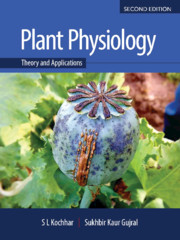Book contents
- Frontmatter
- Contents
- Foreword
- Preface to the Second Edition
- Preface to the First Edition
- Acknowledgements
- Some Common Abbreviations used in the Text
- Abbreviations for Units
- Unit I Water and Mineral Translocation in Plants
- Unit II Metabolism and Bioenergetics
- Unit III Growth and Development
- Unit IV Physiological Stress and Secondary Metabolites – Their Role in Metabolism
- Unit V Crop Physiology – An Innovative Approach
- Unit VI Breakthroughs in Plant Physiology
- Unit VII Some Experimental Exercises
- Glossary
- References
- Index
- Colour Plates
Chapter 8 - Carbohydrate Metabolism
Published online by Cambridge University Press: 12 May 2020
- Frontmatter
- Contents
- Foreword
- Preface to the Second Edition
- Preface to the First Edition
- Acknowledgements
- Some Common Abbreviations used in the Text
- Abbreviations for Units
- Unit I Water and Mineral Translocation in Plants
- Unit II Metabolism and Bioenergetics
- Unit III Growth and Development
- Unit IV Physiological Stress and Secondary Metabolites – Their Role in Metabolism
- Unit V Crop Physiology – An Innovative Approach
- Unit VI Breakthroughs in Plant Physiology
- Unit VII Some Experimental Exercises
- Glossary
- References
- Index
- Colour Plates
Summary
Sucrose and Starch Metabolism
Sucrose and starch, the principal leaf storage products, are biosynthesized in two different compartments – sucrose in the cytoplasm of photosynthetic cells and starch in the chloroplast. Both the compounds accumulate in daylight and are mobilised to meet the metabolic demands during night time or at the time of minimum photosynthetic yield. The pathway for sucrose synthesis is highly regulated and synchronized with the pathway associated with starch synthesis.
The appropriation of carbon fixed by the Calvin cycle into either starch or sucrose synthesis is referred to as carbon allocation.
Sucrose biosynthesis
Sucrose is the most common type of carbohydrate present in the translocation stream (Figure 8.1). Plants such as wheat, oats and barley temporarily accumulate large quantities of sucrose in the vacuole. Sucrose (non-reducing sugar) is a disaccharide and each molecule is composed of two monosaccharides, glucose and fructose (reducing sugars). Instead of free glucose and fructose, phosphorylated forms of these sugars serve as precursors of sucrose.
Uridine diphosphate-glucose (UDP-G) is the most preferred precursor for sucrose biosynthesis in the cytoplasm of cells of the leaf.
Reactions involved in the pathway of sucrose formation are as follows:
Overall equation for sucrose synthesis is
Only one ATP molecule is essential for the biosynthesis of sucrose. Since three ATP molecules are consumed in the Calvin cycle for each carbon in each hexose of sucrose (a total of 36 ATPs), one additional ATP needed to form a glycosidic bond in sucrose is a small additional requirement.
Sucrose exported from the leaf cell to non-photosynthetic tissues may be oxidized quickly or stored in the vacuoles for a short period or gets transformed to starch for long-term storage in the chloroplast.
Regulation of sucrose-6-phosphate synthase: Sucrose phosphate synthase (SPS) is a key regulatory enzyme in sucrose biosynthesis and catalyzes the transfer of a glucose molecule from UDP-glucose to fructose-6-phosphate to yield sucrose-6-phosphate and UDP.
SPS is regulated via reversible protein phosphorylation and dephosphorylation. For example, SPS kinase causes phosphorylation of the enzyme sucrose phosphate synthase, thus converting this to an ‘inactive’ form while SPS phosphatase enzyme dephosphorylates the enzyme, thus, activating it.
- Type
- Chapter
- Information
- Plant PhysiologyTheory and Applications, pp. 253 - 266Publisher: Cambridge University PressPrint publication year: 2020



